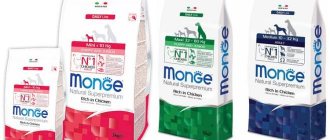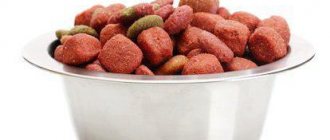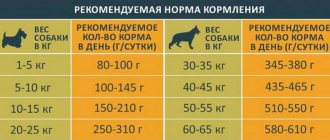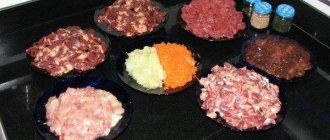Dog food, low protein food brands
Protein is as important for overall growth, cell development, and damage control in the human body as it is in dogs. In general, protein is an extremely important component of a dog’s diet. Since dogs are quite active creatures, they use up energy and enzymes obtained from protein. Overall, protein is essential for vital functions such as tissue maintenance, production and growth, strengthening the immune system, maintaining connections and skin, and maintaining a dog's metabolic rate. Considering this fact, the idea of feeding a dog a low protein diet seems crazy. However, there are certain dog health conditions that are caused by high levels of protein and deposits in the dog's body. In such cases, finding the best low protein dog food is a major challenge.
What is dietary dog food?
The symptoms of the pathology are varied and depend on the nosology of the disease. The basic line of treatment for various diseases in dogs is a therapeutic diet, which is characterized by the complete or partial exclusion of certain foods from the diet, replacement of certain ingredients, and changing the ratio of proteins, fats and carbohydrates.
Some therapeutic diets involve changing the calorie content of the product or increasing micro- and macroelements.
Crude protein
It is important to emphasize that it is “crude protein” that is indicated on the packaging in the guaranteed analysis of the feed, and there is no information about how easily it is absorbed by the body. There are many sources of protein, even leather boots, chicken feathers or cow hooves are quite high in crude protein, but the body can only absorb a small portion of it, at the cost of hard work and therefore stress on the entire system.
This is why we must understand that the percentage of protein in a guaranteed feed analysis does not indicate its quality at all. The ingredient list won't tell you the whole story either, but at least you can understand whether the food contains quality protein.
Features of the use of dietary food for dogs
Pet owners should remember that they should never select dry dietary food for dogs on their own. At the first symptoms of the disease, regardless of its nature, it is necessary to visit a veterinarian.
A consultation with a doctor, often an additional examination, will help identify the problem and eliminate it in a timely manner.
The principles of diet therapy include:
- Therapeutic food is chosen depending on the specific pathology. Almost all well-known dog food manufacturers produce dietary series of dry food. However, the composition of each of the available varieties is unique and adjusted for a specific pathology.
- Dietary therapy is carried out either for life (for example, with a congenital or hereditary disease) or until the end of the disease. The specific duration of the therapeutic diet is determined by the veterinarian. Even the disappearance of symptoms does not always mean a complete cure for the pet.
- All dietary dog foods have a high cost and are produced in a premium series. However, you should not replace them with cheap analogues. Saving on a pet is completely unacceptable and can cause irreparable harm to the animal.
When choosing this or that product, you should pay attention to the quality composition, carefully familiarize yourself with the labeling of the produced series (dietary food for dogs with obesity, diabetes, urolithiasis).
The rating of the manufacturing company is important. Most veterinarians will advise and even prescribe appropriate nutritional therapy.
To reassure the manufacturer, you can read reviews of dietary dog food of a specific brand. Such practical aspects as the tightness of packaging, the condition of the feed, its color, and the presence of pathological impurities do not lose their relevance.
Low Protein Food Recipes for Dogs
It is common knowledge that homemade dog food is the healthiest alternative to avoiding the harmful effects of commercial dog food. There are many low protein recipes that you can prepare at home. Here are some of the best low-protein dog recipes. These recipes will save you the trouble of searching for the best brands of low protein dog food.
Recipe No. 1 Ingredients
- 1 large egg
- 3 potatoes
- 1 tbsp. chicken fat
- ½ multivitamin/mineral tablet
- 1 ½ tablets calcium carbonate
Method of preparation: Boil the egg and potatoes with skins. Peel the egg, leave the potatoes with the skin on, then mash and add all the other ingredients and feed to the dog. Leftovers can be stored in the refrigerator in an airtight container.
Recipe No. 2 Ingredients
- ¼ pound ground beef
- 1 hard-boiled egg
- 2 cups cooked rice
- 1 tsp calcium carbonate or 1 tablet for heaviness in the stomach
- 3 slices crumbled bread
Directions: Boil beef until golden brown, then add remaining ingredients. Mix well and give to your dog. Leftovers can be stored in an airtight container in the refrigerator.
As a warning, we note that since the low protein diet is a prescribed diet, you should only use it under the advice of a veterinarian. Also keep in mind that the brands of low protein dog food listed are available by prescription only. This means that the dog must also be fed as prescribed.
Protein is as important for overall growth, cell development, and damage control in the human body as it is in dogs.
In general, protein is an extremely important component of a dog’s diet. Since dogs are quite active creatures, they use up energy and enzymes obtained from protein. Overall, protein is essential for vital functions such as tissue maintenance, production and growth, strengthening the immune system, maintaining connections and skin, and maintaining a dog's metabolic rate. Considering this fact, the idea of feeding a dog a low protein diet seems crazy. However, there are certain dog health conditions that are caused by high levels of protein and deposits in the dog's body. In such cases, finding the best low protein dog food is a major challenge.
Dietary food for dogs with gastrointestinal diseases
Pathology of the gastrointestinal tract of dogs is a fairly common problem that requires mandatory adherence to a therapeutic diet.
Specialized pet food has a number of features:
- The dietary (hypoallergenic, due to the high degree of connection between allergies and gastrointestinal diseases) dog food contains a significantly reduced portion of fat, which reduces the load on the digestive tract. Animal fats are an active stimulator of gastric and intestinal motility and activators of pancreatic enzymes. Partial exclusion of the ingredient from the diet allows you to slow down the processes of uncontrolled motor activity, as well as reduce the intensity of gas formation.
- The mass fraction of protein has been significantly increased.
- An essential component of medicinal feeds are prebiotic complexes that promote the growth and development of beneficial bacteria in the intestines.
- The high content of unsaturated fatty acids promotes the binding of toxins and their rapid removal from the animal’s digestive tract.
- All medicinal foods do not contain aromatic additives and dyes, which are powerful activators of food allergies and acute inflammatory reactions on the gastric mucosa.
Medicinal food products are produced by companies such as Royal Canine, Hills, Farmina Vet. Only qualified veterinarians take part in the development of dietary formulas, assessing the main gastroenterological problems in dogs and how to solve them.
The role of protein in the animal body
First and foremost: protein is not just a nutrient. It is made up of amino acids, which serve as building blocks for the formation of body tissues, organs, enzymes, hormones, antibodies, and so on. About half of a dog's dry body mass is made up of protein.
During the growth period, puppies need protein for the formation of tissues, organs, the production of enzymes, hormones and antibodies. And adult dogs, just like puppies, constantly need it to regenerate all of the above. The body itself is capable of synthesizing many amino acids, but it is also necessary that they come from outside, especially essential ones.
Contrary to popular belief and the claims of food manufacturers, dogs (and cats) do not themselves know how much water they need to replenish the lack of liquid in dry food. This is why I strongly recommend that owners always fill the bowl with plenty of water when feeding the animal.
Dietary food for dogs with kidney diseases
Kidney disease in dogs is a fairly common problem.
Most often, kidney failure or decreased renal function is caused by urolithiasis, severe poisoning, as a result of the natural aging of the pet.
Already well-known manufacturing companies launch medicinal products on the market with the following features:
- Due to the large loss of protein, the mass fraction of essential amino acids and whole protein has been increased in the composition of dietary mixtures. These same components, together with enzymes, help build muscle mass in the animal.
- The carbohydrate fraction is increased due to easily digestible sugars. This ingredient is responsible for a number of metabolic processes and helps increase the pet’s activity.
- The high content of unsaturated fatty acids is aimed at binding toxins, as kidney function is reduced.
- In the high-quality composition of medicinal food, you can notice a reduced amount of phosphorus, sodium and some trace elements. This feature allows you to moderately relieve the function of the renal apparatus.
When producing a medicinal product, great attention is paid to the content of alkaline and acidic components, which is important for maintaining an optimal level of urine acidity.
Physiological protein needs of dogs
Dogs have a certain physiological need for protein, which largely depends on physical activity and living conditions in each specific situation. Young animals, as well as those living on the street or experiencing intense stress, require more of it than inactive and elderly animals. The data varies somewhat among different sources, but on average, dogs require 4.5-6.0 grams of protein per kilogram of body weight per day, and at high loads and during the growth period - up to 9.0 g.
How well do commercially prepared diets satisfy a dog’s protein needs? Each of you can find out using this method:
Let's take for example a dog weighing 30 kg and dry food that contains 24% protein. In order to make the calculation, you need to look at the bag for the daily feeding requirement for a dog of that body weight. Let's say that in this case it is 400 g.
The amount of protein in 100g of feed (24%) is divided by 100 and multiplied by the daily feed intake (400g). We count:
24: 100 * 400 = 96 g - this is exactly how much protein the animal will receive per day.
We divide the result (total amount of protein) by the dog’s weight (30 kg) and find out how much protein it receives per 1 kg of its own weight per day:
96: 30 = 3.2 g – per kilogram of weight.
Next, you need to compare the resulting figure with the dog’s needs, which we wrote about above. As you can see, in this example this indicator does not reach the average values and is very far from the maximum limit of 9 grams.
The manufacturer of commercially prepared diets, Acana and Orijen, has the philosophy that dogs should be fed according to their biological needs, and above all, their diet should be balanced in protein content. How does this philosophy translate into practice? Let's look at a specific example.
Orijen dry food contains 38% protein, and its daily dosage for the same 30-kg dog is 330 grams.
38: 100 * 330 = 125.4 g – per day;
125.4: 30 = 4.18 g – per kilogram of weight.
This figure is as close as possible to the average requirements for a dog with a normal level of activity, so we are talking about an optimal, and not at all a high, level of protein. Animals with special needs related to their lifestyle need to increase the daily allowance in the recommended amounts.
Dietary food for dogs with diabetes
Diabetes mellitus is an incurable disease that must be accompanied by strict adherence to nutritional therapy. Actually, diet is the basic point of rational therapy for the pathology of the endocrine system.
A pet with a similar disease may encounter problems such as stool disturbances, changes in appetite, intestinal colic, and irritable bowel syndrome. In addition, due to low levels of glucose in the cells, the daily activity of dogs is reduced.
High levels of glucose in the blood lead to increased thirst, a number of skin diseases, and decreased immunity. In the absence of proper treatment, coma, kidney failure, gradual atrophy of the optic nerve and many other problems develop.
Developers of specialized dog food took into account all the features of diet therapy for diabetes:
- Farmina produces dietary food with an optimal ratio of monosaccharides. This product is used in conjunction with insulin therapy.
- The food produced by Advance is aimed at normalizing the functioning of the digestive tract. All products in this line are enriched with unsaturated fatty acids, which helps maintain intestinal motility at the proper level.
Much attention is paid to the quantitative and qualitative content of plant fiber in the product. It is important not to cause allergies in your pet, but at the same time, increasing fiber accelerates the elimination of toxins and normalizes intestinal function.
How much protein is contained in meat and industrial feed?
Now that we've got the basics out of the way, let's get back to the protein content of pet foods. Many cite long-outdated studies claiming that high-protein dog food is harmful and causes diseases in various organs, primarily the liver and kidneys. But the fact is that these studies concern feeds containing low-quality, poorly digestible proteins: soybeans, corn, offal, blood meal, and so on.
Rather, the health of the kidneys and liver depends precisely on the quality of proteins. Wolves in the wild eat almost nothing but meat, and kidney disease is less common in them than in domestic dogs. But their source of protein is high-quality meat and internal organs, and not waste from the meat industry and cereals that are used to produce feed.
In addition, meat contains about 70% liquid, while most commercial dry foods contain a maximum of 10%. Dogs and other canids have evolved to eat a diet of meat, fat, and bones—which is what they have eaten for hundreds of thousands of years.
Commercial feeds, especially dry foods, have only become widespread in the last 80 years, and they have both supporters and opponents, and their application is still the subject of research.
Dietary food for dogs for cardiovascular diseases
Dietary foods for dogs with heart and vascular pathologies also have their own characteristics:
- In a number of cardiovascular diseases, the pumping function of the heart is dramatically reduced, the mobility of the valve apparatus may change, and the elasticity of the myocardium may change. The amount of sodium is significantly reduced, which allows you to maintain water load, the level of blood volume in the desired range, and reduce the load on the heart.
- For pathologies accompanied by arrhythmias and impulse conduction disorders in the heart, lines of dietary feeds with a high content of potassium and magnesium have been developed.
As in all cases of diseases in dogs, it is important to seek help from a veterinarian in time and determine the pathology. This is especially true for diseases of the cardiovascular system, because the wrong approach to diet can aggravate the pathology.
Plant and animal protein in dog food
Let's get back to our proteins. Protein in dog food can be of both plant and animal origin. Plant-based sources are cheaper, especially corn gluten meal, the most popular and cheapest source of protein, a food industry byproduct obtained from the production of corn starch and corn syrup. This meal contains 60% crude protein, so theoretically, if you have no protein sources at all, you can make a food with 20% crude protein by mixing corn meal with some cheap source of carbohydrates in a 1:2 ratio.











